
Treasury remains one of the most misunderstood yet essential functions in any business. From ensuring liquidity to managing financial risks, treasurers play a pivotal role in navigating companies through uncertain waters. However, over the years, I’ve encountered several myths and misconceptions about treasury—ideas that limit its perceived value or oversimplify its complexity.
Let’s explore The 12 Myths of Treasury and set the record straight.
Myth 1: Treasury Is Just About Cash Management
Treasurers are often seen as mere cash managers, limited to handling payments and ensuring liquidity. Some organizations treat treasurers as the “cashiers” of the company, while there are even CFOs reserving tasks like debt negotiations with banks – the perceived “glamorous” side of treasury – for themselves. Treasury goes far beyond cash management. It’s a strategic function that safeguards financial stability, manages risk, and drives growth through proactive planning and collaboration. Treasurers are not just managing the present they’re shaping the future of the business.

Myth 2: Treasurers Don’t Need to Understand the Business
Treasurers are often viewed as isolated from the broader business, focusing solely on numbers and financial transactions. Many believe that understanding the company’s operations, strategy, or market dynamics isn’t essential for their role.
Treasurers must deeply understand the business to manage liquidity, risks, and funding effectively. Their role requires a comprehensive view of the company’s operations and strategic goals to make informed decisions and align financial strategies with business needs.
From my own experience, I’ve seen how critical this understanding is. The more we understand the business and communicate within the organization with all the business units, the more we can add strategic depth to our role and provide solutions.
I recall a case where a CIO was exploring a Treasury Management Systems (TMS) without involving treasury in the process. The lack of collaboration could have led to a solution that didn’t meet the company’s actual needs, emphasizing the importance of treasury being part of key business decisions.
I’ve often collaborated internally with teams like procurement, logistics and HR. I remember instances when they brought issues to my office, and together, we worked on solutions that balanced financial strategy and operational needs. These moments underline the value of treasury’s deep involvement in the business.
On the other hand, knowing the business and being able to guide through site visit banks or external stakeholders, have made my feel great satisfaction whilst showcasing the operations firsthand. This helps them not only understand our business better but also strengthens our relationship and credibility.
Treasurers are not just “number people.” They are business partners who bring financial expertise into the operational, strategic, and external landscapes of a company.
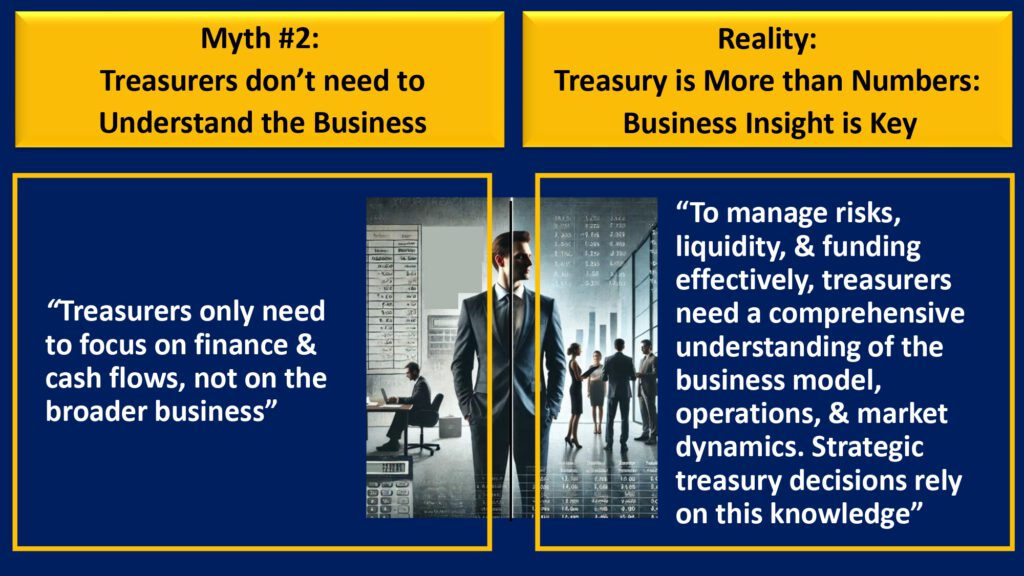
Myth 3: Treasury and Accounting Are the Same Thing
Treasury and Accounting are often seen as interchangeable roles within finance. Treasurers are assumed to perform tasks like bank transactions and account reconciliations or interest accounting entries, leading to the belief that their work and responsibilities are identical to those of accountants. Some even argue that Treasury should report to Accounting or even that salaries should be equivalent, perpetuating the misunderstanding.
Treasurers are not Accountants. Their role requires a different skill set, a broader understanding of financial markets, and a strategic mindset. Recognizing this distinction is key to unlocking treasury’s full potential.
While Treasury and Accounting share common ground, they serve distinct purposes. Accounting is backward-looking, focused on recording and reporting historical financial information. Treasury, on the other hand, is forward-looking, focused on managing liquidity, mitigating risks, and aligning financial strategies with the company’s long-term goals.
Separating these two functions is essential for compliance and governance. For example, if Treasury manages payments and also reconciles bank accounts, there’s no independent oversight, increasing the risk of errors or fraud. By keeping these functions separate, companies create a system of checks and balances that enhances transparency and accountability.
Another reason for separation lies in the different areas of expertise. Treasury for instance focuses on forecasting and securing funding to maintain liquidity, while Accounting ensures accurate reporting and compliance with financial regulations. Each department’s specialization allows them to complement each other effectively without overlap. At the end, the true success lies in fostering strong collaboration between these departments to achieve aligned financial goals.

Myth 4: Treasurers Only Work with Banks
Treasurers are often perceived as solely managing relationships with banks—handling loans, deposits, and payment systems. This narrow view overlooks the broad scope of their responsibilities and the diverse stakeholders they collaborate with to ensure the company’s financial stability.
While banking relationships are an important part of Treasury, they’re far from the only focus. Treasurers also work with suppliers, customers, rating agencies, auditors, and even internal teams like procurement to manage liquidity and financial risks.
For example, for working capital management, treasurers collaborate with supply chain and procurement teams to optimize payment terms with suppliers and ensure cash flow aligns with operational needs. Similarly, they may work with rating agencies to improve the company’s credit profile, directly impacting borrowing costs and access to funding. Other cases as well are with technology providers for treasury automation as treasurers are increasingly involved in selecting and implementing TMS and automation tools.
Treasury’s role extends beyond transactional banking to becoming a strategic partner that bridges the internal and external financial landscape, aligning liquidity, risk, and funding strategies with broader business goals.
Treasurers don’t just “work with banks”—they work across the organization and with external stakeholders to drive value and financial resilience.
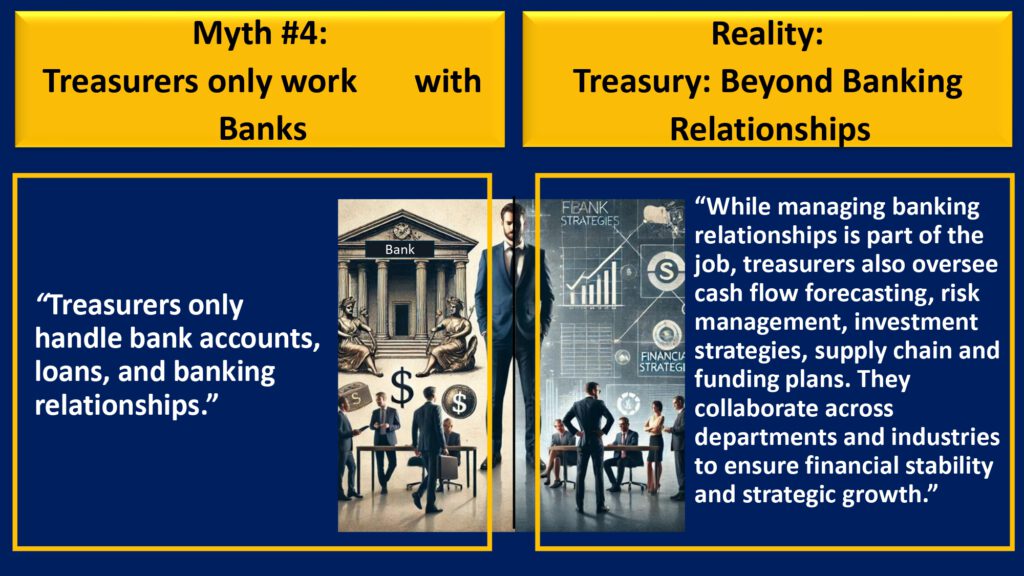
Myth 5: Technology Will Make Treasurers Obsolete
With the rapid rise of automation, APIs, and AI-powered tools, some believe that technology will eventually replace the need for treasurers altogether. This view assumes that treasury tasks are primarily transactional and can be fully automated.
Technology is not a replacement for treasurers but an enabler of their work. While automation tools like APIs, RPAs, and TMS systems streamline processes and reduce manual work, they do not replace the strategic judgment, risk management expertise, and forward-thinking that treasurers bring to the table.
For example,
- APIs now enable real-time connectivity with banks, allowing treasurers to retrieve data directly from bank platforms.
- RPA (Robotic Process Automation) can be used to format this data into structured reports.
- Machine learning (ML) is also being utilized to create advances cash flow forecasting models, enabling treasurers to predict liquidity needs with greater accuracy and adapt to market volatility more effectively.
- Large Language Models (LLMs), used for comparing and summarizing, enable treasurers to quickly analyze and identify discrepancies in agreements, improving efficiency and decision-making while maintaining compliance.
These tools free up treasurers’ time to focus on higher-value activities like liquidity planning, funding strategies, and risk mitigation. Technology supports their role but does not replace their expertise and judgment.
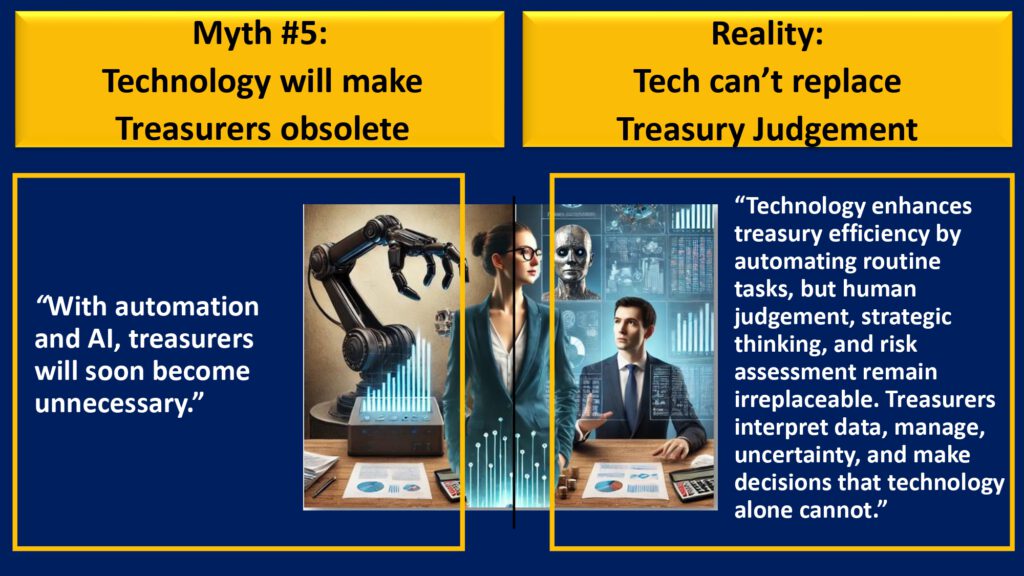
Myth 6: Treasury Doesn’t Add Value to the Business
Treasury is often viewed as a cost center, with its activities seen as transactional or administrative. Some believe that treasury doesn’t contribute directly to the company’s bottom line or long-term success.
Treasury is a cornerstone of business success. From ensuring liquidity to managing risks, treasurers play a vital role in keeping the company financially stable and strategically agile. Their work often enables the entire organization to grow and adapt, especially during turbulent times.
From my own career, I’ve seen treasury lead the way during moments of crisis. During the liquidity crunch and capital controls in Greece, treasury took center stage in guiding operations and navigating the business through uncharted waters.
In another case, when liquidity was scarce, treasury implemented new processes for payments, engaging the whole organization to be partners and successfully pass the milestone.
Working close with credit insurance companies, an invisible partner to each company’s cash flow management, to ensure appropriate credit limits for the supplier is another example as well.
Treasury’s role extends even further during M&A periods. Having participated in a couple of M&A transactions, I’ve seen firsthand how the knowledge treasury has of the business makes us an integral part of the due diligence process, the financing of the deal aas well as the following day . By working closely with cross-functional teams, treasury helps secure the best possible outcomes for the organization.
Treasury’s contributions don’t stop at crisis management or even at treasury related projects. By introducing automation to enhance visibility, such as expense and invoice management systems, treasury has driven efficiency and improved decision-making across the organization—well beyond its traditional scope. Treasurers don’t just add value; they create it by driving resilience, growth, and innovation.

Myth 7: Treasurers Don’t Need Leadership Skills
Treasurers are often seen as technical specialists who focus purely on numbers, systems, and processes. This view assumes that leadership isn’t necessary for their role since they are perceived as operating in the background, removed from decision-making or team management.
Treasurers are not just number crunchers—they are leaders. Whether it’s managing teams, influencing stakeholders, or guiding the organization through financial crises, strong leadership skills are essential to success in treasury.
Treasurers are increasingly recognized as strategic leaders. There is an increasing trend of treasurers being invited to participate in executive committees, advisory boards or even hold board positions, reflecting their influence and ability to navigate complex challenges.
Interestingly, there’s a misconception about what leadership means in treasury (and not only). I’ve encountered situations in interviews, where the focus was solely on how many people I had in my team. Explaining that how leadership in treasury often involves cross-functional efforts and influencing stakeholders across departments –rather than simply managing a large team– was not always easily understood. True leadership in treasury lies in the ability to align diverse functions and drive strategic outcomes, not just in the number of direct reports.
In times of crisis, treasury leadership becomes even more apparent.
During liquidity crunches, treasurers lead efforts to stabilize cash flow, negotiate with banks, suppliers, and customers, and implement innovative solutions like real-time cash flow forecasting tools. By fostering collaboration across teams and maintaining clear communication with stakeholders, treasury ensures financial resilience and continuity. Leadership is about more than giving directions—it’s about inspiring trust, making tough decisions, and ensuring the entire organization feels confident in its financial future. Without strong leadership, treasury’s strategic potential cannot be fully realized.
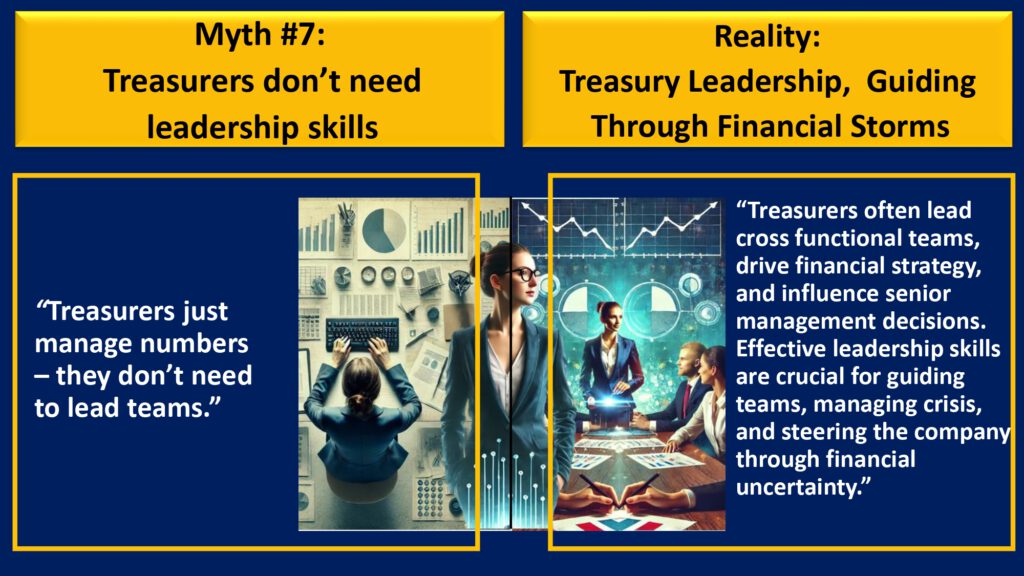
Myth 8: Treasury Is Only Relevant in Large Companies
There’s a belief that treasury is a function reserved for large corporations with complex financial structures and significant cash flows. Smaller businesses or organizations with simple structures—such as single-entity operations—often assume their treasury needs are minimal or non-existent. Statements like, “Our company doesn’t have a group of entities, so our treasury function is simple and easy,” are common misconceptions.
Additionally, some finance directors in businesses exceeding €100 million in revenue believe treasury isn’t necessary because they view their responsibilities as limited to cash collection, payments, and managing loans. What they often fail to recognize is that adding a treasurer not only enhances financial optimization but also frees up their time to focus on more strategic aspects of the business.
Treasury is essential in businesses of all sizes and structures. While the complexity of operations may differ, the principles of managing liquidity, optimizing cash flow, and mitigating financial risks are universal. There’s no revenue threshold or number of entities in a group that dictates the necessity of a treasury function—it’s about ensuring the financial health and efficiency of the organization.
For example, in smaller companies, treasurers may focus on managing liquidity to ensure operational stability, negotiating funding with banks, or implementing tools for cash flow forecasting. Even in a straightforward business model, treasury brings expertise that can uncover efficiencies, improve cost structures, and mitigate risks that might otherwise be overlooked.
From my own experience, I’ve seen treasury play a pivotal role in medium-sized companies, implementing strategies that not only stabilized cash flow but also supported growth and innovation. The misconception that treasury is irrelevant in smaller or simpler organizations often leads to missed opportunities for financial resilience and optimization. Treasury isn’t about the size of the company; it’s about the importance of managing its financial health strategically and efficiently—no matter the scale or complexity.
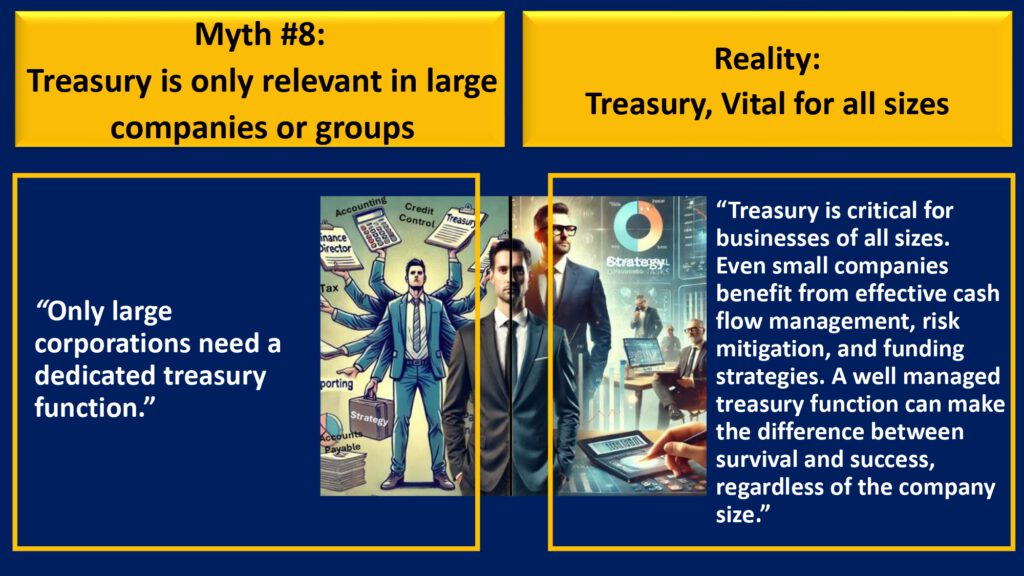
Myth 9: FX Hedging Is Just Gambling
There’s a common perception that FX hedging is risky, speculative, and akin to gambling. Some believe it’s about taking chances on currency fluctuations rather than strategically managing financial risks.
FX hedging is far from gambling—it’s a calculated risk management strategy. By mitigating exposure to currency fluctuations, treasurers protect the company’s cash flows, profitability, and overall financial health. It’s about predictability and stability, not speculation.
I recall once, when presenting internally the hedging of an foreign currency, an executive telling me, “If you knew where exchange rates would move, you wouldn’t be working for a company—you’d be a freelancer making millions from speculation.” The reality is, treasurers are risk-averse by nature, and hedging is about safeguarding the business, not betting on markets.
For example, hedging an investment/CAPEX with predetermined payment schedules, we protect cash flows by ensuring the company is not exposed to unexpected rate changes.
Treasurers are risk averse but the truth is that we usually we don’t proceed with 100% hedging. Even hedging partially, say 50%, can provide better accuracy in cash flow forecasting while allowing flexibility for market conditions. It depends upon the risk appetite of the company, and the risk policies in place.
Another challenge that I’ve faced, is addressing the perception that hedging is expensive. It’s important to note that hedging is most effective when markets are stable — delaying action until volatility strikes, such as say waiting for the Russian ruble to devalue before considering a hedge, is both costly and in many cases too late. Treasurers must be proactive to avoid compounding risks. The problem though is that only when the problem arises, treasury is heard. FX hedging is not about speculation; it’s about preparation. By implementing thoughtful strategies, treasurers enable the business to navigate global markets confidently and focus on growth without fear of financial surprises.

Myth 10: Treasury is All About Short-Term Tasks
Treasury is often perceived as being focused solely on day-to-day operational tasks like payments, cash management, or bank reconciliations. This view reduces treasury to a transactional function rather than a strategic one, tied to the company’s long-term goals.
Treasury plays a critical role in shaping a company’s long-term financial stability and strategic direction. While day-to-day operations are part of treasury’s responsibilities, the true value lies in long-term planning, risk management, and supporting the company’s broader strategic objectives.
I’ve seen treasury lead initiatives that go beyond the transactional. Whether it’s designing a multi-year funding strategy to support growth, navigating complex M&A financing structures, or collaborating with other departments to align financial planning with corporate goals, treasury often acts as the backbone of a company’s financial future.
For example, when treasurers are structuring and managing long term bond loans (5-7 years tenors) or setting up project financing that can reach a tenor of 15 years, treasury should ensure sustainable cash flows over the life of the loan or project financing and align with capital repayment schedules to avoid liquidity constraints. Thus it is of high significance for both the treasurer and the business to be an integral participant during the setting up of the organization’s business plans.
Additionally, treasury is integral to M&A transactions and investment plans, working on long-term funding strategies, aligning liquidity needs with the company’s growth ambitions and at the end assisting further in the smooth integration of the newly acquired company. These responsibilities require detailed forecasting, risk mitigation, and alignment with corporate strategies to maintain financial health. Treasury is not just about short-term operations; it’s about creating long-term value and ensuring the organization thrives in an ever-changing financial landscape.
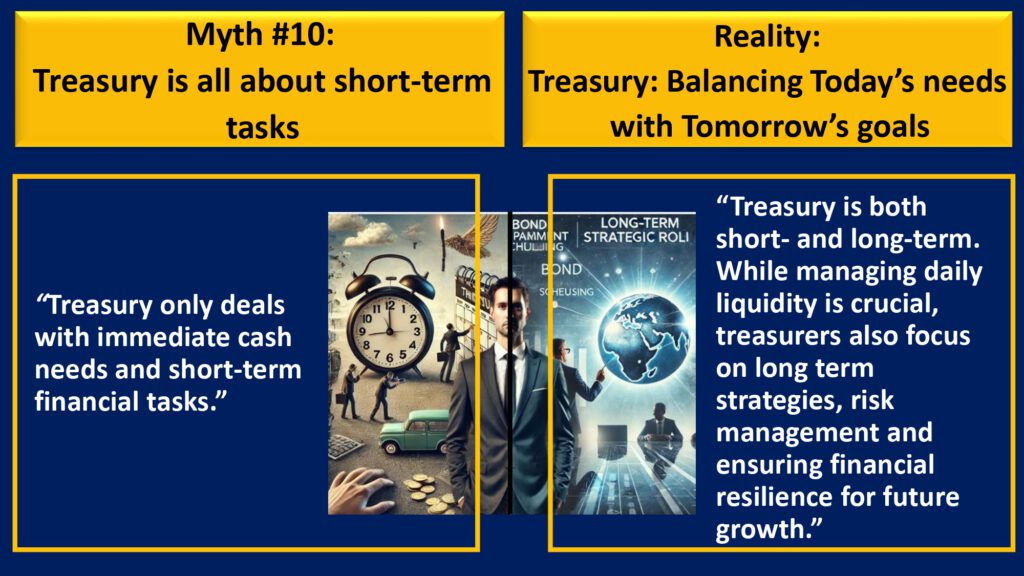
Myth 11: Liquidity Will Always Be Available When Needed
There’s a dangerous assumption that liquidity is something businesses can always access when required, whether through cash reserves, credit lines, or financing options. This belief overlooks the complexities and challenges involved in maintaining liquidity, especially during periods of economic uncertainty or market volatility.
Liquidity is not guaranteed—it requires careful planning, proactive management, and constant vigilance. Treasurers play a critical role in ensuring that liquidity is not only available but also accessible at the right time and in the right place, particularly in large group structures. It’s not uncommon for a group to have sufficient liquidity overall but find it locked in a subsidiary where transferring it isn’t feasible, or where the most effective method, such as a dividend payment, isn’t applicable. Managing these complexities requires foresight and coordination.
Treasurers must also contend with the reality that funding availability can be inconsistent. Financial institutions often seem to act like offering umbrellas on sunny days –providing credit during stable periods- but withdrawing support when the clouds gather. I recall a specific instance during the Greek liquidity crisis when foreign banks began exiting the market and demanded repayment of overdraft facilities within days. Fortunately, we had proactively secured sufficient credit lines with local Greek financial institutions, allowing us to navigate this challenge without disrupting operations.
From my own experience, relying on external funding or credit lines without a robust liquidity management plan can backfire. Proactively building cash buffers, diversifying funding sources, and maintaining strong banking relationships are essential strategies to ensure stability during turbulent times.
Treasurers also prepare for unexpected events by implementing cash flow forecasting models, managing intercompany funding arrangements, and ensuring alignment with business needs. Effective liquidity management isn’t just about having cash—it’s about ensuring it’s accessible when and where it’s needed most. Liquidity isn’t always available—it’s built through foresight, strategic planning, and a comprehensive understanding of business needs and constraints.

Myth 12: Any Finance Professional Can Handle Treasury
There’s a common belief that treasury is simply an extension of finance, and any finance professional—be it an accountant, controller, or finance director—can seamlessly manage treasury functions. This myth diminishes the specialized skills, expertise, and strategic mindset that treasury demands.
Treasury is a distinct and highly specialized discipline. While it intersects with other financial roles, treasury requires a unique combination of technical expertise and soft skills that sets it apart from other finance functions.
Treasurers must possess exceptional communication skills, as they often act as a bridge between internal teams and external stakeholders like banks, investors, and rating agencies. They need problem-solving abilities to untangle complex financial puzzles, and out-of-the-box thinking to devise creative solutions in high-pressure situations. Organizational skills are critical to managing multiple priorities, from liquidity planning to risk management, while maintaining a clear focus on the company’s strategic objectives.
One skill that stands out is the ability to say “no” firmly, but constructively. Treasurers often face requests or ideas that could compromise the company’s financial health, and it’s their responsibility to push back—but always with well-considered alternatives that align with the company’s goals.
From my own experience, I’ve seen cases where finance professionals underestimated the complexity of treasury. They excelled in areas like accounting or controlling but lacked the market knowledge, adaptability, and strategic mindset required for treasury’s dynamic challenges. Treasury is not just a function; it’s a strategic pillar that requires dedicated focus, unique skills, and the ability to thrive in uncertainty. As we step into 2025, let’s acknowledge treasury for the unique, specialized discipline it is and celebrate the professionals who master its complexities and drive business resilience and success.

Conclusion
The role of treasury is ever-evolving, and these myths only scratch the surface of its potential. By challenging these misconceptions, we can elevate treasury’s profile and showcase its importance in building resilient, growth-oriented businesses.
What’s the biggest misconception you’ve encountered about treasury? Share your experiences and let’s continue the conversation. Together, we can reshape how treasury is perceived and ensure its value is recognized.
Join our Treasury Community
Treasury Mastermind is a community of professionals working in treasury management or those interested in learning more about various topics related to treasury management, including cash management, foreign exchange management, and payments. To register and connect with Treasury professionals, click [HERE] or fill out the form below to get more information.
Excellent overview of Treasures’ perception painful points! I wish it could have been distributed among other stakeholders like financial controllers (accountants), auditors, Tax, Sr. Management, etc. Quite often there is indeed a misconseption of Treasurers’ role. Once I even heard a comment from a colleague that Treasury is seen as an extention of a Tax department “Tax & Treasury” and should report to a Tax Director (manager).